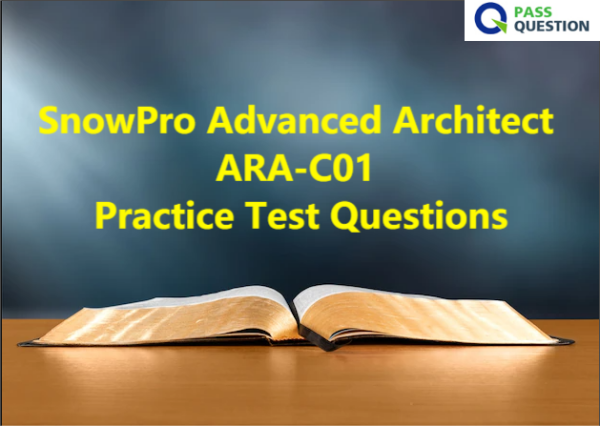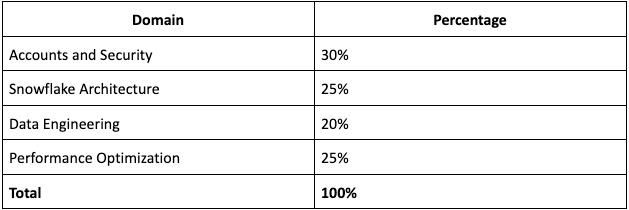The Snowflake SnowPro Advanced Architect Certification will validate advanced knowledge and skills to apply comprehensive architect solutions using Snowflake. PassQuestion provides the latest SnowPro Advanced Architect ARA-C01 Practice Test Questions which are very similar to the practice test as well as the real exam. It is strongly recommended to ensure that we have covered all the objectives of the certification exam so that you can pass the exam easily on your first attempt. Hence, keep practicing until you are confident to take the real exams. Once you have spent some time learning these SnowPro Advanced Architect ARA-C01 Practice Test Questions, then you can face the real exam with more confidence and ensure passing it on your first attempt.

[ARA-C01] SnowPro Advanced: Architect Exam
A certified SnowPro Advanced, Architect has demonstrated specific knowledge and skills related to the design, development, and implementation of Snowflake solutions by successfully passing the certification exam. The individual has demonstrated the application of Snowflake best practices, advanced tuning, and real-world deployment scenarios.
SnowPro Advanced: Architect Certification Candidate
- 2+ years of practical experience with Snowflake as an Architect in a production environment. In these two years, successful candidates would have achieved hands-on expertise with SQL and SQL analytics, experience building out a complex ETL/ELT pipeline, experience implementing security and compliance requirements, and working with different data modeling techniques.
- Having coding experience outside of SQL and DevOps/DataOps design experience is a plus.
Exam Format
Exam Version: ARA-C01
Total Number of Questions: 65
Question Types: Multiple Select, Multiple Choice, True/False
Time Limit: 115 minutes
Languages: English
Registration Fee: $375 USD
Passing Score: 750 + Scaled Scoring from 0 - 1000
Prerequisites: SnowPro Core Certified
Exam Domain Breakdown

1.0 Domain: Account and Security
1.1 Design a Snowflake account and database strategy, based on business requirements.
Create and configure Snowflake parameters based on a central account and any additional accounts.
List the benefits and limitations of one Snowflake account as compared to multiple Snowflake accounts.
1.2 Design an architecture that meets data security, privacy, compliance, and governance requirements.
Configure Role Based Access Control (RBAC) hierarchy
System roles and associated best practices
Data Access
Data Security
Compliance
1.3 Outline Snowflake security principles and identify use cases where they should be applied.
Encryption
Network security
User, Role, Grants provisioning
Authentication
2.0 Domain:Snowflake Architecture
2.1 Outline the benefits and limitations of various data models in a Snowflake environment.
Data models
2.2 Design data sharing solutions, based on different use cases.
Use Cases
Sharing within the same organization/same Snowflake account
Sharing within a cloud region
Sharing across cloud regions
Sharing between different Snowflake accounts
Sharing to a non-Snowflake customer
Sharing Across platforms
Data Exchange
Data Sharing Methods
2.3 Create architecture solutions that support Development Lifecycles as well as workload requirements.
Data Lake and Environments
Workloads
Development lifecycle support
2.4 Given a scenario, outline how objects exist within the Snowflake Object hierarchy and how the hierarchy impacts an architecture.
Roles
Warehouses
Object hierarchy
Database
2.5 Determine the appropriate data recovery solution in Snowflake and how data can be restored.
Backup/Recovery
Disaster Recovery
3.0 Domain: Data Engineering
3.1 Determine the appropriate data loading or data unloading solution to meet business needs.
Data sources
Ingestion of the data
Architecture Changes
Data unloading
3.2 Outline key tools in Snowflake’s ecosystem and how they interact with Snowflake.
Connectors
Kafka
Spark
Python
Drivers
JDBC
OBDC
API endpoints
SnowSQL
3.3 Determine the appropriate data transformation solution to meet business needs.
Materialized Views, Views and Secure Views
Staging layers and tables
Querying semi-structured data
Data processing
Stored Procedures
Streams and Tasks
Functions
4.0 Domain: Performance Optimization
4.1 Outline performance tools, best practices, and appropriate scenarios where they should be applied.
Query profiling
Virtual Warehouse configuration
Clustering
Search Optimization
Caching
Query rewrite
4.2 Troubleshoot performance issues with existing architectures.
JOIN explosions
Warehouse selection (scaling up as compared to scaling out)
Best practices and optimization techniques
Duplication of data
View Online SnowPro Advanced Architect Certification ARA-C01 Free Questions
1. Which of the following statements are TRUE concerning a data consumer account in Snowflake?
A. All objects in the shared database are always read-only for the consumer of the share
B. A consumer of a share does not necessarily need an account with Snowflake to be able to consume data
C. A consumer account must be in the same region and on the same cloud provider as the data provider account
D. A consumer needs to pay for the compute and storage of the shared data
E. A database ‘share’ can be ‘imported’ by at most 10 consumer accounts
Answers: A, B
2. Which of the following statements are FALSE concerning a data consumer account in Snowflake?
A. A single consumer account can contain objects from different providers
B. A consumer account can create clones of a shared database
C. A consumer account can perform time travel on a table within the shared database
D. A consumer account cannot forward (i.e. reshare) the shared databases and objects
Answers: B, C
3. Which of the following objects will NOT be cloned when cloning a schema?
A. A permanent Table
B. A temporary Table
C. A transient Table
D. An external table
E. Views
F. Internal (named) Stage
G. Stored Procedures
Answers: B, D, F
4. Select appropriate database objects which can NOT be part of a direct share.
A. Tables
B. External Tables
C. External Stages
D. Secure views
E. Secure Materialized views
F. Stored Procedure
Answers: C, F
5. To list all privileges and roles that a role named PYTHON_DEV_ROLE has, which of the following commands is the most appropriate one to use?
A. show grants
B. show grants in role PYTHON_DEV_ROLE
C. show grants of role PYTHON_DEV_ROLE
D. show grants to role PYTHON_DEV_ROLE
Answer: D
6. Which of the following programming languages are supported in Snowflake to write UDFs?
A. SQL
B. Java
C. .NET
D. C++
E. JavaScript
F. Python
Answers: A, B, E, F
7. In which of the following languages, can you write a stored procedure in Snowflake?
A. SQL
B. Java
C. Scala
D. JavaScript
E. Python
F. Snowflake Scripting
Answers: B, C, D, E, F
8. Which of the following are TRUE statements with respect to the Snowflake Connector for Kafka?
A. The Kafka connector relies on both – key pair authentication and username/password authentication
B. It is recommended to run your Kafka Connect instance in the same cloud provider region as your Snowflake account
C. Kafka connect cluster is a separate cluster from the Kafka cluster
D. The typical pattern with Kafka connect cluster in Snowflake is that one topic supplies messages (rows) for many Snowflake tables and many Kafka topics supply messages to one Snowflake table (i.e. many-to-many relationship)
Answers: B, C

No comments yet